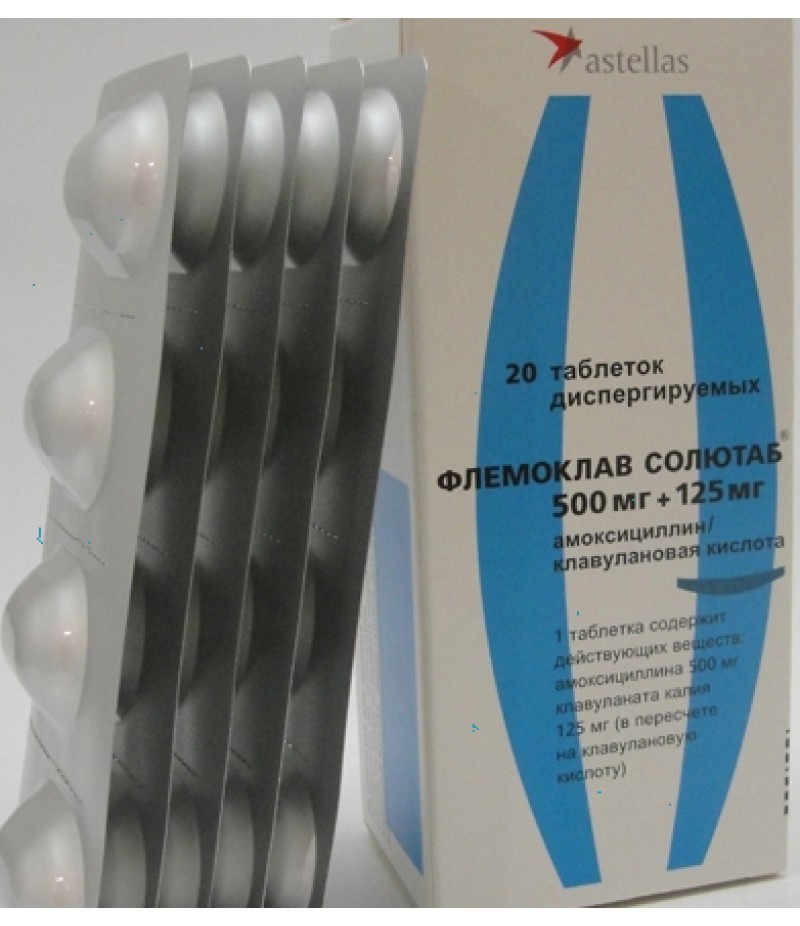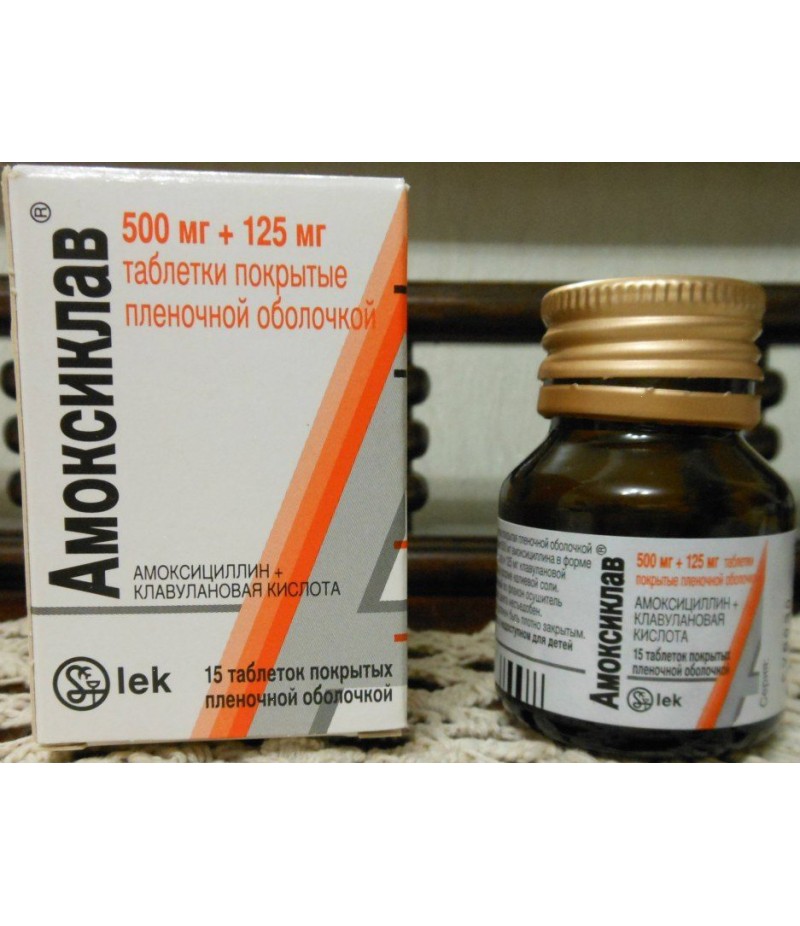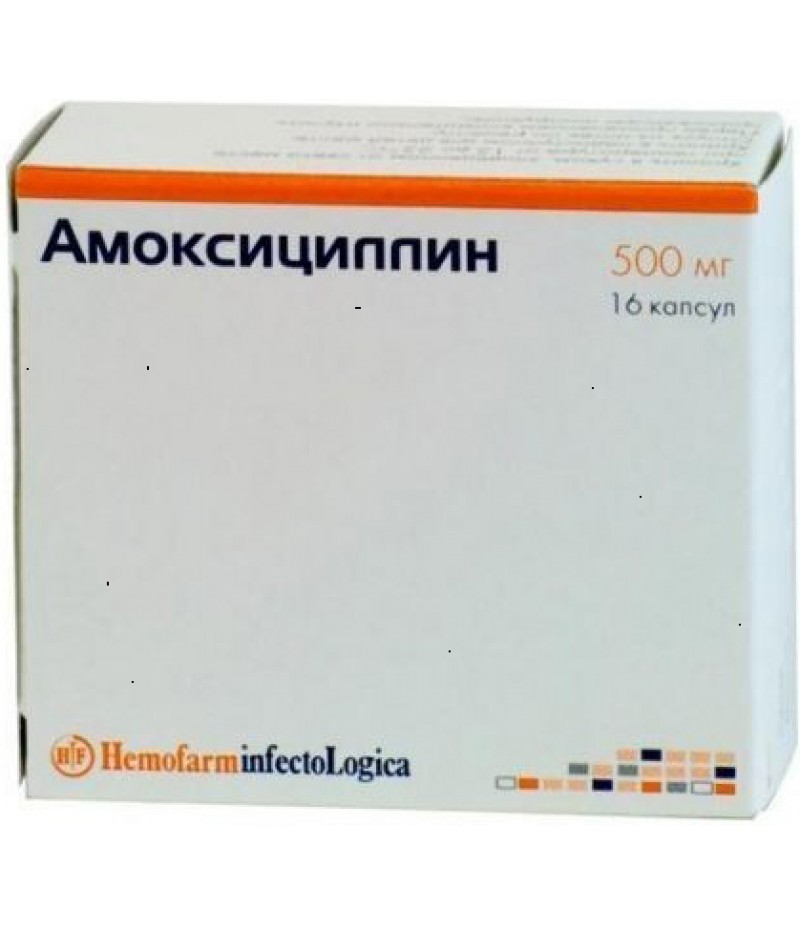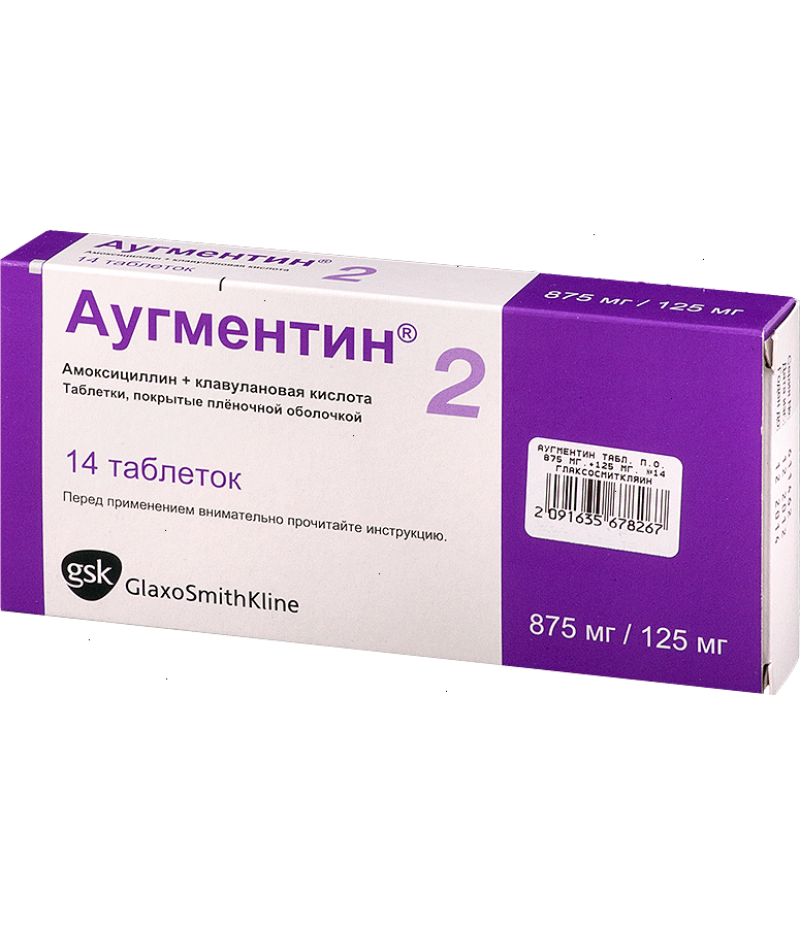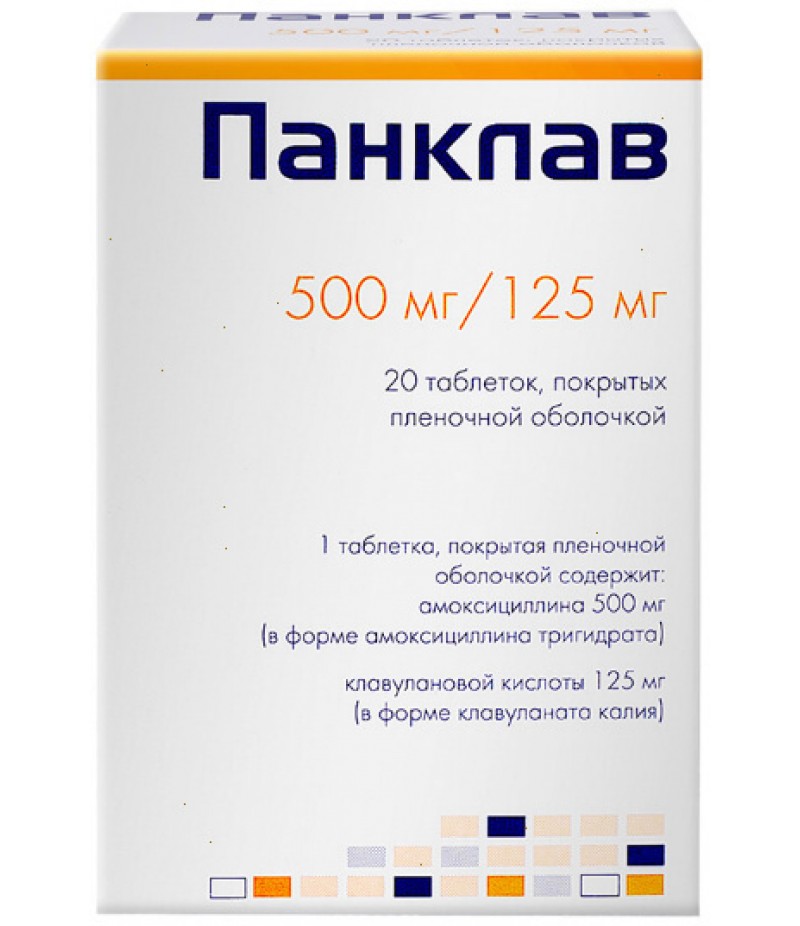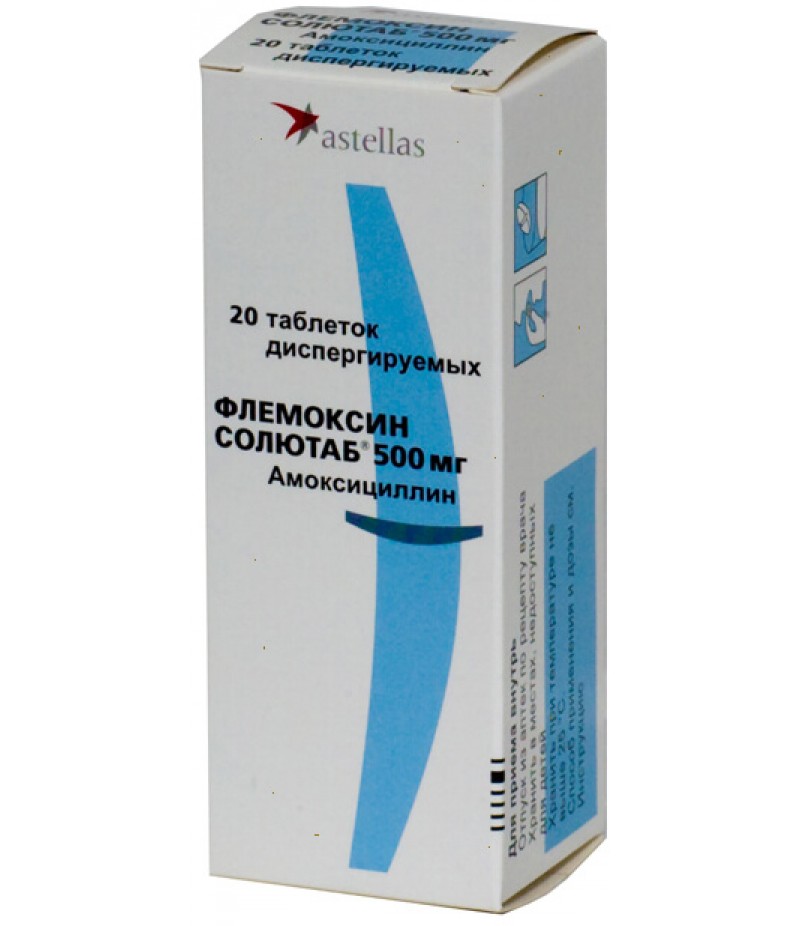Flemoсlav Solutab 500mg #20
- $21.36
- 3 or more $19.99
- Availability:In Stock
Flemoсlav Solutab instruction manualCompositionTablets Flemoklav Solutab can be produced in four different dosages: clavulanic acid (potassium clavulanate) - 31.25 mg, amoxicillin (amoxicillin trihydrate) -125 mg..
Flemoсlav Solutab instruction manual
Composition
Tablets Flemoklav Solutab can be produced in four different dosages:
clavulanic acid (potassium clavulanate) - 31.25 mg, amoxicillin (amoxicillin trihydrate) -125 mg;
clavulanic acid (potassium clavulanate) - 62.5 mg, amoxicillin (amoxicillin trihydrate) 250 mg;
clavulanic acid (potassium clavulanate) 125 mg, amoxicillin (amoxicillin trihydrate) 500 mg;
clavulanic acid (potassium clavulanate) 125 mg, amoxicillin (amoxicillin trihydrate) 875 mg.
Excipients are: dispersed cellulose, MCC, vanillin, crospovidone, mandarin flavor, lemon flavor, saccharin, magnesium stearate.
Form of issue
Tablets of white or straw color, oblong form, with engraving "425" and the logo of the firm; there may be single brown spots.
7 tablets of antibiotic Flemoclav Solutab with total mass of active substances 1000 mg (amoxicillin 875 mg + clavulonic acid 125 mg) are enclosed in a blister, 2 such blisters in paper packaging.
Tablets of other dosages are enclosed in blisters for 4 pieces, 5 such blisters in paper packaging.
pharmachologic effect
This medicine has antibacterial action.
Pharmacodynamics and pharmacokinetics
Pharmacodynamics
Flemoclav Solutab is an antibiotic with a rather wide spectrum of action, it contains clavulanic acid and amoxicillin.
The drug is active against gram-negative and gram-positive bacteria (including species that synthesize beta-lactamases), inhibits the synthesis of peptidoglycan (an element of the cell wall of microorganisms).
Clavulanic acid suppresses 5, 4, 3 and 2 types of beta-lactamases and is inactive with respect to type 1 beta-lactamases synthesized by Enterobacter spp., Pseudomonas aeruginosa, Acinetobacter spp. Forms a complex with proteins and prevents enzymatic denaturation of amoxicillin under the influence of beta-lactamases, thus expanding the spectrum of the Flemoklava Solutab.
Sensitive in vitro to amoxicillin microorganisms:
Gram-positive aerobic bacteria - Enterococcus faecalis, Nocardia asteroids, Bacillus anthracis, Gardnerella vaginalis, Streptococcus pneumoniae, Listeria monocytogenes, Streptococcus pyogenes and some other beta-hemolytic Streptococcus strains, methicylensensitive strains of Staphylococcus saprophyticus, Staphylococcus aureus, Staphylococcus aureus, coagulase-negative staphylococci;
Gram-negative aerobic bacteria - Haemophilus influenza, Bordetella pertussis, Helicobacter pylori, Haemophilus parainfluenzae, Asteurella multocida, Moraxella catarrhalis, PVibrio cholera;
Gram-positive anaerobic bacteria - some species of Clostridium, Peptostreptococcus micros, Peptostreptococcus magnus, Peptococcus niger, some species of Peptostreptococcus;
Gram-negative anaerobic bacteria - some species of Bacteroides, Capnocytophaga, Eikenella corrodens, Fusobacterium, Porphyromonas, Prevotella;
others: Leptospirosa ictterohaemorrhagiae, Treponema pallidum.
Stresses in which resistance may occur:
Gram-negative aerobic bacteria - Klesiella pneumonia, Escherichia coli, Klebsiella species, Proteus vulgaris, Proteus mirabilis, Proteus species, Salmonella species, Shigella species;
Gram-positive aerobic bacteria - Enterococcus faecium, species of Corynebacterium.
Resistant microorganisms:
Gram-negative aerobic bacteria - Citrobacter freundii, Acinetobacter species, Enterobacter species, Providencia species, Serratia species, Pseudomonas, Hafnia alvei, Morganella morganii, Legionella pneumophila, Stenotrophomas maltophilia;
others are species of Chlamydia, Coxiella burnetti, Mycoplasma species.
Pharmacokinetics
After penetration of the drug with a dose of 875/125 mg (amoxicillin / clavulanic acid) into the intestine, the concentration of amoxicillin in the blood reaches a maximum value after 90 minutes, clavulanic acid - after 60 minutes.
Bioavailability of amoxicillin with oral intake of about 90%, absorption of clavulanic acid reaches 60%.
Approximately 20% of amoxicillin and 21% of clavulanic acid form bonds with blood proteins. The half-life of amoxicillin is 1 hour, clavulanic acid is 50 minutes. Approximately 70% of amoxicillin and 40% of clavulanic acid are excreted by the kidneys in the first 5.5 hours.
The therapeutic concentrations of both substances can be achieved in the gallbladder, abdominal cavity, muscle tissue, skin, bile, peritoneal and synovial fluids, pus.
Indications for use
Infectious diseases of inflammatory nature, caused by microorganisms sensitive to Flemoklava:
infection of ENT organs and respiratory tract (COPD, exacerbation of chronic bronchitis, otitis media, tonsillitis, pharyngitis, sinusitis, out-of-hospital pneumonia);
gynecological infections;
infection of joints and bones, including osteomyelitis;
infections of soft tissues and skin;
infection of the genitourinary system (cystitis, pyelonephritis).
Contraindications
Severe liver damage after taking the drug in the past.
Lymphocytic leukemia.
Infectious mononucleosis.
Renal failure (filtration below 30 ml per minute) - for tablets 875/125 mg.
Age less than 12 years and weight up to 40 kg - for tablets 875/125 mg.
Hypersensitivity to the components of the drug and any beta-lactam antibiotics (cephalosporins and penicillins).
With caution use the drug in severe forms of hepatic and renal failure, diseases of the digestive system.
Side effects
From the nervous system: less than 0.001% - headache, convulsions (with drug overdose); less than 0.0001% - anxiety, hyperactivity, impaired consciousness, insomnia, anxiety, aggressive behavior.
On the part of the hemopoietic system - hemolytic anemia, thrombocytosis; in less than 0.0001% - granulocytopenia, leukopenia, thrombocytopenia, pancytopenia, increase in clotting time.
On the part of the digestive system: less than 0.1% - nausea, abdominal pain, diarrhea, vomiting, pseudomembranous colitis; less than 0.001% - hemorrhagic colitis, intestinal candidiasis, discoloration of tooth enamel.
On the vascular side: less than 0.001% - vasculitis.
On the part of the liver: less than 0.1% - increased activity of transaminases; jaundice and hepatitis, less than 0.001%.
On the part of the genitourinary tract: less than 0.01% - burning, itching and discharge from the vagina; less than 0.001% - nephritis.
Allergic reactions: less than 0.1% - hives, itching; less than 0.001% - dermatitis, anaphylactic shock, Quincke's edema, serum sickness.
Other: less than 0.01% - superinfection of bacterial or fungal origin (with frequent and prolonged drug treatment).
Instruction on Flemoclav Solutab
Instructions for use Flemoclav Solutab recommends adults, children under 12 and children under the age of twelve, weighing more than 40 kilograms, take this antibiotic at a dose of 875 + 125 mg (the total dose of active ingredients is 1000 mg) twice a day (for chronic, recurrent infectious diseases dose increase by half).
Children under 12 years of age and weighing less than 40 kilograms are prescribed medication in weaker dosages (Flemoclav 250 mg + 62.5 mg and Flemoclav 500 mg + 125 mg).
Adults and children weighing 40 kilograms are recommended Flemoklav Solutab 500mg + 125mg three times a day.
The daily dose for children under 12 and weighing up to 40 kilograms is 5 mg of clavulanic acid and 25 mg of amoxicillin per kilogram of weight.
In severe infectious and inflammatory diseases, these doses can be doubled, but it is forbidden to exceed the dose of 60 mg of amoxicillin and 15 mg of clavulanic acid per kilogram of body weight per day.
The duration of treatment with the drug should not exceed two weeks.
In patients with concomitant renal failure Flemoclav Solutab 875 mg / 125 mg can be used if the rate of renal filtration is more than 30 ml per minute.
To reduce the risk of side effects from the digestive organs, the drug should be taken immediately before meals. The tablet should be swallowed whole, washed down with water, or dissolved in 50 ml of water, completely stirring before use.
Overdose
Overdose phenomena are usually reduced to such intestinal symptoms as nausea and diarrhea.
Less often when using large doses of the drug may appear convulsions, coma, hemolysis, kidney failure.
Treatment. Reception of activated carbon and osmodiuretics. Maintaining the water and mineral balance. Cramps with diazepam. In case of serious violations from the kidneys, hemodialysis is necessary. In the rest, the treatment is symptomatic.
Interaction
Other antibiotics. Flemoclav Solutab should not be shared with bacteriostatic drugs / chemotherapy / disulfiram / antibiotics (chloramphenicol, macrolides, tetracycline, sulfonamides).
Drugs that inhibit the excretion of amoxicillin by the kidneys. Simultaneous administration with phenylbutazone, probenecid, oxyphenbutazone, indomethacin, acetylsalicylic acid and sulfinpyrazone can cause an increase in the concentration of amoxicillin in the blood and in bile. The excretion of clavulanic acid in similar cases does not change.
Allopurinol. Its use with amoxicillin increases the risk of skin rashes.
Methotrexate. Admission of amoxicillin reduces the excretion of methotrexate by the kidneys, so the occurrence of toxic effects. It is necessary to monitor the level of the latter in the blood.
Digoxin. Flemoclav Solutab increases the absorption of digoxin in the intestine.
Anticoagulants. The combination of medication with indirect anticoagulants may cause an increased risk of bleeding.
Hormonal contraceptives. Amoxicillin in rare cases can inhibit the effects of oral contraceptives.
Storage conditions
Store at temperatures up to 25 ° C. Keep away from children!
During storage, single dark spots can form on the tablets.
It is forbidden to use the drug after the expiration date (indicated on the package).
Shelf life
24 months.
special instructions
Before the beginning of treatment with Flemoclavum Solutab it is necessary to exclude the presence in the past of allergic reactions to cephalosporins, penicillins or constituents of the drug.
This drug should not be administered if there is a suspicion of infectious mononucleosis, since amoxicillin was reported in this situation for cases of koreal-like eruptions.
Persons with severe forms of allergies and bronchial asthma should be cautious when using the drug.
There is the possibility of cross-resistance and allergic reactions with other cephalosporins or penicillins.
Long-term use of the drug causes the emergence and growth of resistant to Flemoklava Solutab microflora, as well as fungal or bacterial superinfection.
Use with caution in people with liver disease, there is a risk of jaundice.
Due to the high content of amoxicillin in the urine, it is possible for it to settle on the walls of the urethral catheter, therefore it is necessary to regularly change the catheter.
The appearance of generalized erythema accompanied by fever and pustular rash at the beginning of therapy may be a sign of acute exanthematous pustules. In this case, you must stop taking the drug.
In case of seizures, treatment with the drug is canceled.
It should be remembered that one tablet Flemoklava Solyutab 875/125 mg contains 0.025 g of potassium.
Flemoclav Solutab for children
The section "Instruction on the Flemoclav Solutab" clearly indicates how to take this medication to children. The maximum daily dosage for children should not exceed 15 mg of clavulanic acid and 60 mg of amoxicillin per kilogram of body weight.
Reports of the occurrence of side effects in general are not typical for children's reviews. The price of small doses of the drug differs favorably from the price of the Flemoclav Solutab in a dose of 875/125 mg.
With alcohol
It is advisable to refrain from taking alcohol during the treatment with the drug.
In pregnancy and lactation
No reports of toxic effects on the fetus or newborns of amoxicillin and clavulanic acid have been reported.
Application after the 13th week of pregnancy is possible only according to the doctor's prescription. In the first 12 weeks of pregnancy, the drug is administered at a dosage of 875/125 mg.
The active substances penetrate the placenta and enter the breast milk. This does not prohibit the use of the drug during lactation, but it should be used with caution.
Reviews of Flemoklav Solutab
Reviews of the Flemoklav testify to the high efficiency and rapid onset of the expected effect from the use of the drug. Children are often prescribed additional therapy, preventing the attachment of superinfection and the development of dysbiosis. Reviews in genyantritis report a rapid onset of relief after starting the use of the drug in most patients.

